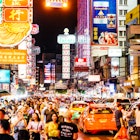
© Kiszon Pascal/Getty Images
Bangkok
Same same, but different. This Thailish T-shirt philosophy sums up Bangkok, a city where the familiar and the exotic collide like the flavors on a plate of pàt tai.
Attractions
Must-see attractions

Ko Ratanakosin & Thonburi
Wat Pho is our absolute favorite among Bangkok's biggest sights. In fact, the compound incorporates a host of superlatives: the city's largest reclining…

Ko Ratanakosin & Thonburi
The Grand Palace (Phra Borom Maharatchawang) is a former royal residence in Bangkok that was consecrated in 1782. Today, it’s only used on ceremonial…

Ko Ratanakosin & Thonburi
Wat Arun is the missile-shaped temple that rises from the Chao Phraya River's banks. Known as Temple of Dawn, it was named after the Indian god of dawn,…

Ko Ratanakosin & Thonburi
Architecturally fantastic, the Wat Phra Kaew temple complex is also the spiritual core of Thai Buddhism and the monarchy, symbolically united in what is…

Banglamphu
Even if you're wát-ed out, you should tackle the brisk ascent to the Golden Mount. Serpentine steps wind through an artificial hill shaded by gnarled…

Bangkok
Named after the Buddha’s birthplace in Nepal (Lumbini), Lumphini Park is central Bangkok’s largest and most popular park. Its 58 hectares are home to an…

Banglamphu
Other than being just plain huge and impressive, Wat Suthat also holds the highest royal temple grade. Inside the wí·hăhn (sanctuary for a Buddha…

Bangkok
You might recognise this iconic temple from its impression on the back of the ubiquitous Thai 5B coin. Also referred to as the Marble Temple, it was…
Planning Tools
Expert guidance to help you plan your trip
Things to Know
Bangkok is a sprawling, bustling city that can be a sensory overload to first-time visitors. Here's what you need to know before you go.
Read articleBest Neighborhoods
Get to know Bangkok's best areas with this neighborhood guide, from sights and nightlife to places to stay.
Read articleDay Trips
Bangkok is big, bold and boisterous and it's easy to feel a little overwhelmed. Escape the city crowds on these fun-filled day trips from Bangkok.
Read articleMoney and Costs
Bangkok has so much to see and do that it can be easy to burn through your baht. Here's how to visit without blowing your budget.
Read articleTransportation
Think the tiger of Thailand’s biggest city can only be tamed by taxi? Mere mortal, here’s how to get around Bangkok.
Read articleFree Things to Do
Bangkok is one of the world's top budget stops and there's plenty to do here that won't cost a baht. Try these top free things to do in the Thai capital.
Read articleTraveling with Kids
From magnificent museums to thrilling theme parks via some fun-filled túk-túk rides, there are plenty of ways to enjoy Bangkok with children in tow.
Read articlePlan with a local

Articles
Latest stories from Bangkok


 Bars & PubsBangkok after dark: craft cocktails, drag shows and underground sounds
Bars & PubsBangkok after dark: craft cocktails, drag shows and underground soundsAug 28, 2024 • 6 min read

 Destination Practicalities9 things you should know before visiting Bangkok
Destination Practicalities9 things you should know before visiting BangkokApr 25, 2024 • 6 min read





in partnership with getyourguide



















